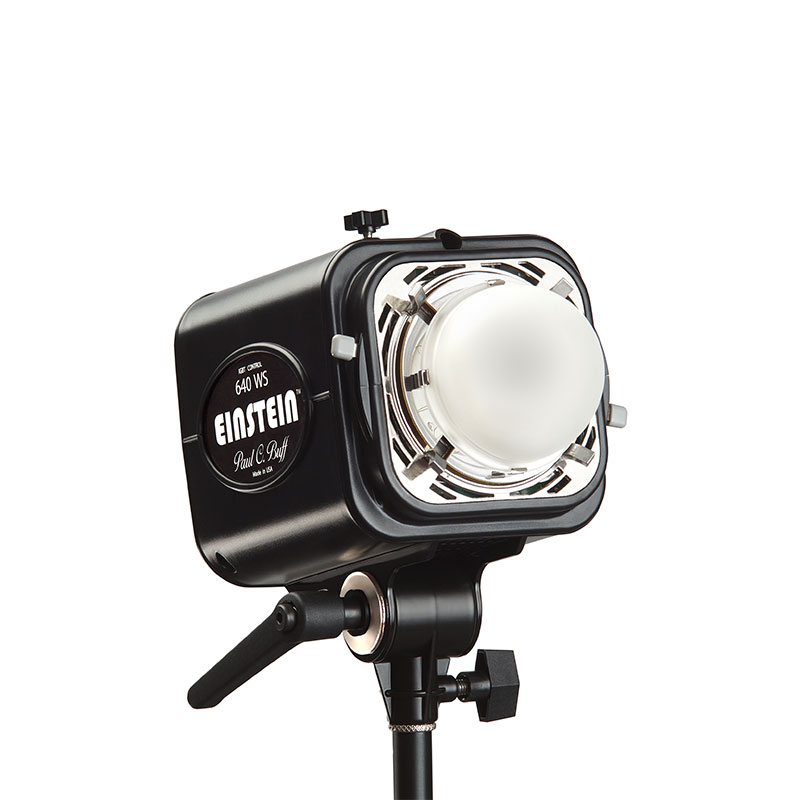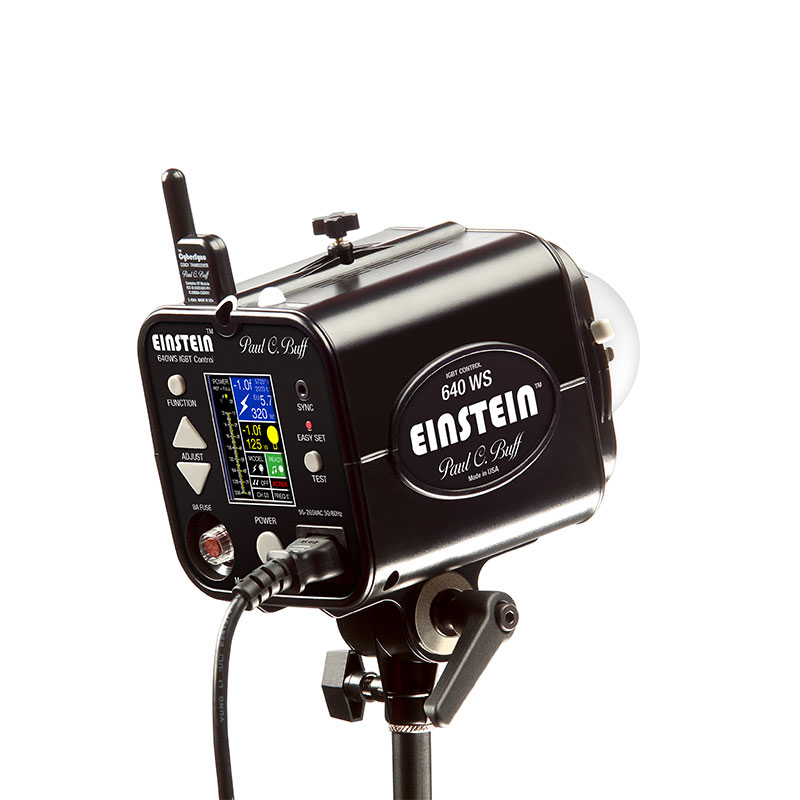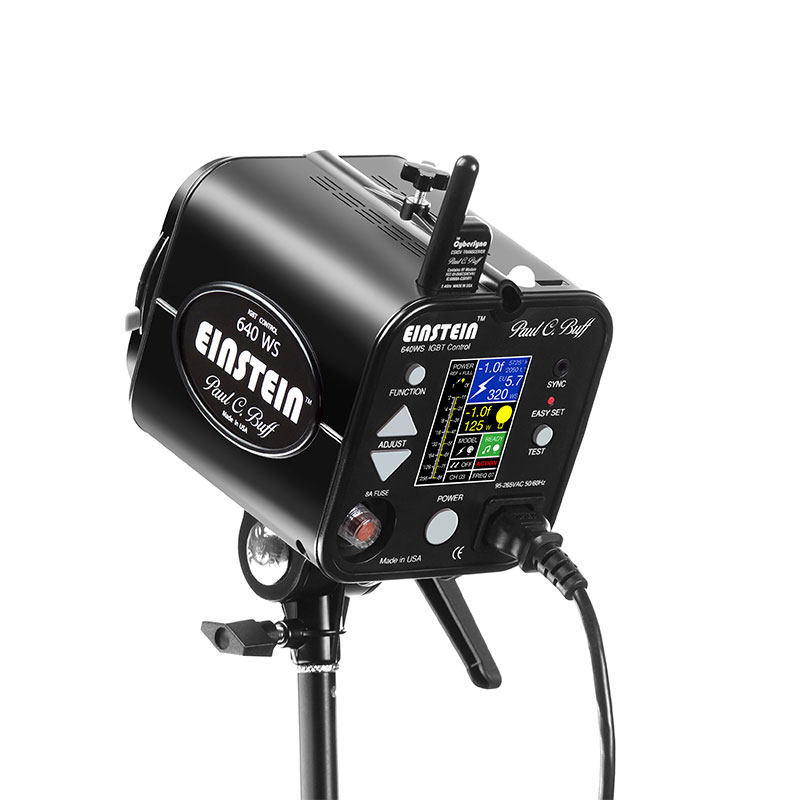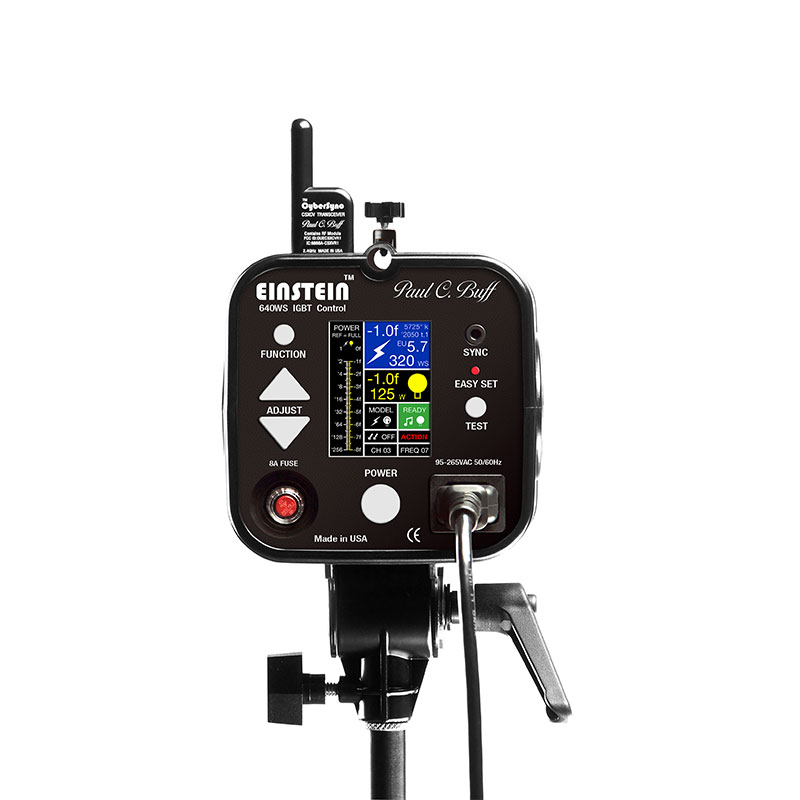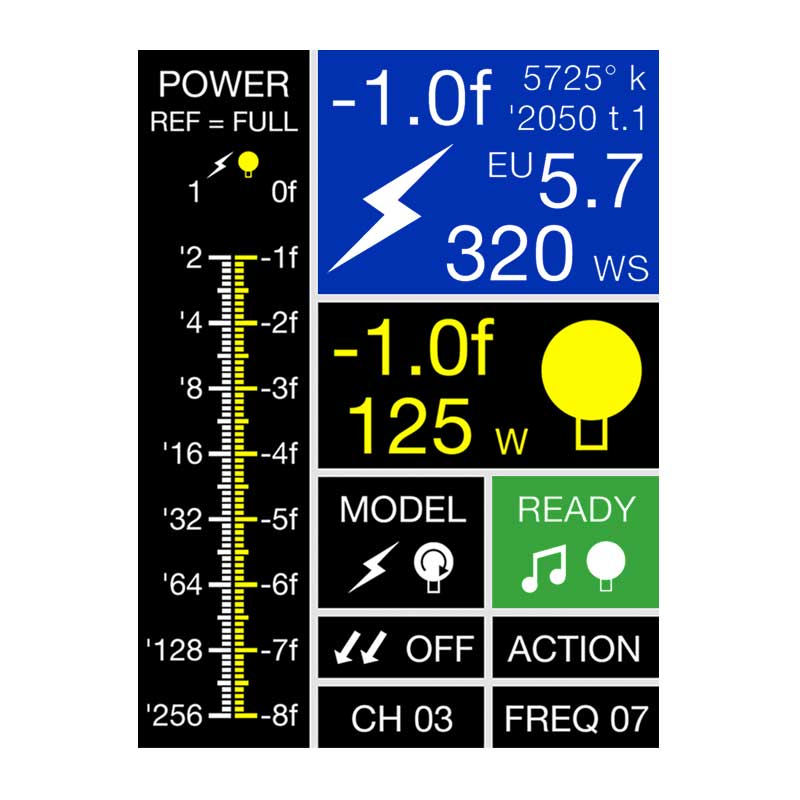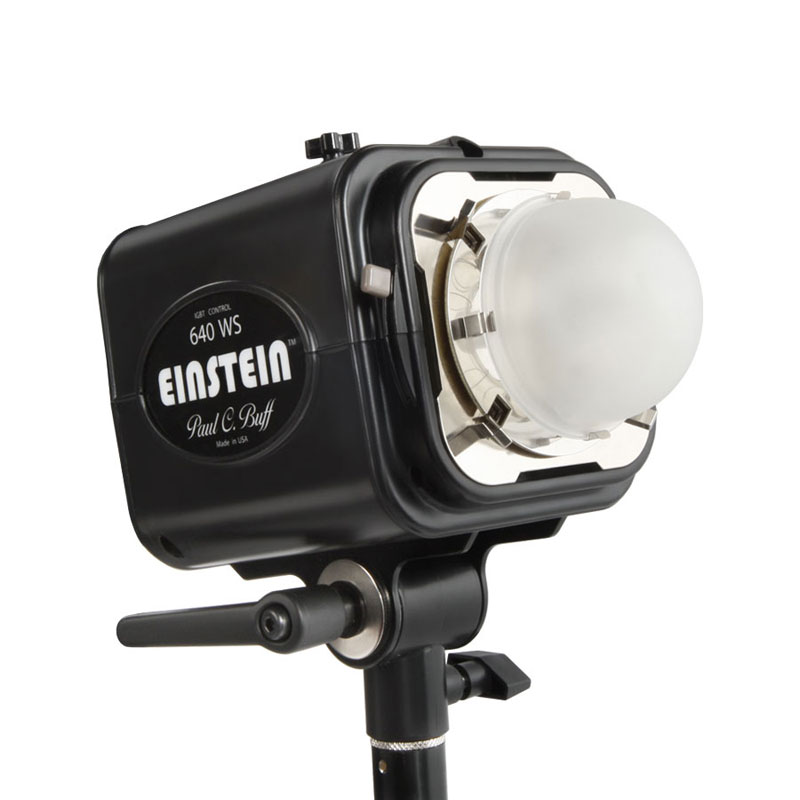- 9 f-stop power variability (2.5 Ws to 640 Ws)
- all-digital control from enormous LCD display
- global plug-and-play from 95 to 265 VAC
- adjustable in precise 1/10 f-stops
- action-stopping up to 1/13,500 second (t.1)
- color consistency +/- 50° at any power
- bright, voltage-controlled 250 Watt modeling lamp
- frosted dome cover reduces UV emission
- audible and visual recycle indicator alert options
- "Easy Set" button for quick return to default settings
- complete remote control capability with CyberSync™
- 60-Day Absolute Satisfaction Guarantee
- 2-Year Factory Warranty
We are pleased to present the most advanced integrated studio flash system ever conceived - Einstein™.
Einstein™ is a powerful, all-digital, self-contained flash unit using multiple IGBT devices to allow a 9 f-stop power variability range from full (640 Ws) to 1/256 power (2.5 Ws), adjustable in precise 1/10 f-stops with voltage regulation consistency over the entire operating range.
Einstein™ offers global plug-and-play with automatic power switching that allows the unit to operate on power lines from 95VAC to 265VAC, 50 or 60Hz, automatically sensing the voltage / frequency and adjusting accordingly with no user attention required.
Einstein™ recycles to full power (at 120VAC or at 240VAC, 50Hz) in just 1.7 seconds, with the recycle time proportionally decreasing as the power setting is reduced. When recycle is complete, the READY state can be indicated both audibly and visually, selectable from the rear panel. An advantage of the IGBT flash control is that, at reduced power settings, the flash capacitors are not completely drained when the unit is fired making it possible to perform a rapid sequence of shots as the unit can be fired before the READY state is reached. Depending on the power setting and number of frames per second being shot, this can produce successive reductions of exposure value and color temperature in a rapid series of shots at relatively high power. In typical fast action sports shooting, setting the power to around 1/10 power (64 Ws) will allow frame rates or bursts on the order of five to ten frames per second with excellent frame to frame consistency and extremely sharp action freezing.
Two distinct operation modes are available from the rear panel: the Constant Color mode and the Action mode. In Constant Color mode, the emitted color temperature is held constant at 5600ºK (+/- 50ºK at any power setting or input voltage). The flash duration ranges from 1/540 second (t.1) at full power to 1/1700 second (t.1) at half power to 1/9,000 second (t.1) at the lowest power setting. In Action mode, the flash duration is minimized for maximum action stopping capability where absolute color consistency is secondary to motion freezing. At half power in Action mode, the flash duration is approximately 1/2000 second (t.1) and the color temperature is approximately 5750º K. In this mode, the color temperature rises as power is reduced.
Einstein™ includes a flash sensitive built-in slave tripper for wireless firing and arrives with a standard 1/8" to PC sync cord for direct camera connection. The unit may also be fired from the optional CyberSync™ CSXCV Transceiver / Cyber Commander™ or third party radio triggers. See the Compatibility tab for more info.
Adjustments are made with the function and adjust buttons on the back control panel, with all parameters displayed on the back-lit, high resolution color LCD screen (320 x 240 pixels, 2.4"). At all times, the screen indicates the output level of the flash (the f-stop, wattseconds, and EU number), the color temperature, the t.1 flash duration, the output level of the modeling lamp (the f-stop and watts), the modeling lamp setting (on, off, track or independently adjustable), the recycle READY status and setting, the slave eye status, the action or color mode selection, and the CyberSync™ channel and frequency selection.
Einstein™ additionally features an "Easy Set" button used for instant setup to the most commonly used function parameters. When pushed, Einstein™ is ready to use in plug-and-play fashion for most users, with both visible and audible READY indicators, the slave sensor on, Constant Color mode selected and CyberSync™ channel/frequency both set to '1'. After pushing the "Easy Set" button, the user can then use the function button to change any of the settings mentioned.
Each unit arrives with a UV-coated, single-ring flashtube and a standard 250 Watt (120V) bayonet-style quartz modeling lamp that is precisely voltage-controlled to maintain consistent luminosity and to track flash power within +/- 1/10 f-stop at any AC input voltage and any power setting within its specification. The design of the modeling lamp regulator is proprietary to Paul C. Buff™ and yields dramatically less interference transmitted back to the power line in comparison to the unregulated and inaccurate household-style "phase control" dimmers used in most flash units. A frosted pyrex dome protects the lamp and tube from damage and serves to reduce UV emission from the flashtube. It equalizes the effective size and shape of the modeling lamp and flashtube as the modeling lamp filament is in exactly the same focal point as the UV-coated flashtube, resulting in an extremely close relationship between the flash and modeling light. The dome lowers the color temperature by approx. 300K. An optional UV-coated dome (sold separately) further lowers the color temperature by approximately 600K.
A high velocity fan and improved airflow coupled with multiple internal heat sensors and circuit fault detection assure reliable performance under the most demanding commercial shooting.
Einstein™ also includes a Micro SD card slot for a standard 2GB card (not supplied), used to upgrade the firmware via download or email should features be added in the future.
Einstein™ is a powerful, all-digital, self-contained flash unit using multiple IGBT devices to allow a 9 f-stop power variability range from full (640 Ws) to 1/256 power (2.5 Ws), adjustable in precise 1/10 f-stops with voltage regulation consistency over the entire operating range.
Einstein™ offers global plug-and-play with automatic power switching that allows the unit to operate on power lines from 95VAC to 265VAC, 50 or 60Hz, automatically sensing the voltage / frequency and adjusting accordingly with no user attention required.
Einstein™ recycles to full power (at 120VAC or at 240VAC, 50Hz) in just 1.7 seconds, with the recycle time proportionally decreasing as the power setting is reduced. When recycle is complete, the READY state can be indicated both audibly and visually, selectable from the rear panel. An advantage of the IGBT flash control is that, at reduced power settings, the flash capacitors are not completely drained when the unit is fired making it possible to perform a rapid sequence of shots as the unit can be fired before the READY state is reached. Depending on the power setting and number of frames per second being shot, this can produce successive reductions of exposure value and color temperature in a rapid series of shots at relatively high power. In typical fast action sports shooting, setting the power to around 1/10 power (64 Ws) will allow frame rates or bursts on the order of five to ten frames per second with excellent frame to frame consistency and extremely sharp action freezing.
Two distinct operation modes are available from the rear panel: the Constant Color mode and the Action mode. In Constant Color mode, the emitted color temperature is held constant at 5600ºK (+/- 50ºK at any power setting or input voltage). The flash duration ranges from 1/540 second (t.1) at full power to 1/1700 second (t.1) at half power to 1/9,000 second (t.1) at the lowest power setting. In Action mode, the flash duration is minimized for maximum action stopping capability where absolute color consistency is secondary to motion freezing. At half power in Action mode, the flash duration is approximately 1/2000 second (t.1) and the color temperature is approximately 5750º K. In this mode, the color temperature rises as power is reduced.
Einstein™ includes a flash sensitive built-in slave tripper for wireless firing and arrives with a standard 1/8" to PC sync cord for direct camera connection. The unit may also be fired from the optional CyberSync™ CSXCV Transceiver / Cyber Commander™ or third party radio triggers. See the Compatibility tab for more info.
Adjustments are made with the function and adjust buttons on the back control panel, with all parameters displayed on the back-lit, high resolution color LCD screen (320 x 240 pixels, 2.4"). At all times, the screen indicates the output level of the flash (the f-stop, wattseconds, and EU number), the color temperature, the t.1 flash duration, the output level of the modeling lamp (the f-stop and watts), the modeling lamp setting (on, off, track or independently adjustable), the recycle READY status and setting, the slave eye status, the action or color mode selection, and the CyberSync™ channel and frequency selection.
Einstein™ additionally features an "Easy Set" button used for instant setup to the most commonly used function parameters. When pushed, Einstein™ is ready to use in plug-and-play fashion for most users, with both visible and audible READY indicators, the slave sensor on, Constant Color mode selected and CyberSync™ channel/frequency both set to '1'. After pushing the "Easy Set" button, the user can then use the function button to change any of the settings mentioned.
Each unit arrives with a UV-coated, single-ring flashtube and a standard 250 Watt (120V) bayonet-style quartz modeling lamp that is precisely voltage-controlled to maintain consistent luminosity and to track flash power within +/- 1/10 f-stop at any AC input voltage and any power setting within its specification. The design of the modeling lamp regulator is proprietary to Paul C. Buff™ and yields dramatically less interference transmitted back to the power line in comparison to the unregulated and inaccurate household-style "phase control" dimmers used in most flash units. A frosted pyrex dome protects the lamp and tube from damage and serves to reduce UV emission from the flashtube. It equalizes the effective size and shape of the modeling lamp and flashtube as the modeling lamp filament is in exactly the same focal point as the UV-coated flashtube, resulting in an extremely close relationship between the flash and modeling light. The dome lowers the color temperature by approx. 300K. An optional UV-coated dome (sold separately) further lowers the color temperature by approximately 600K.
A high velocity fan and improved airflow coupled with multiple internal heat sensors and circuit fault detection assure reliable performance under the most demanding commercial shooting.
Einstein™ also includes a Micro SD card slot for a standard 2GB card (not supplied), used to upgrade the firmware via download or email should features be added in the future.
| Einstein E640 | |
| True Wattseconds | 640 Ws max. at full power; 2.5 Ws min. at 1/256 power |
| Lumenseconds | 28,000 Ls at full power |
| Power Variability | 9 f-stops (full to 1/256 power) |
| Recycle to 100% | 1/10 to 1.7 seconds (may be fired before 100% recycle for speed shooting at reduced power) |
| Flash Duration (t.5) | 1/2,000 second at full power |
| Flash Duration (t.1) - in Action Mode | from 1/588 to 1/13,500 second |
| Flash Duration (t.1) - in Color Mode | from 1/588 to 1/8,000 second |
| Power Requirements | automatic power switching from 95 to 265 VAC, 50/60Hz (no lamp change or user attention required) |
| Average Current Draw | brief initial recycle surge current of 8.5A; average draw of 8A |
| Sync / Trigger Voltage | less than 5 volts, safe for use with digital cameras |
| Modeling Lamp |
250 Watt, 120VAC bayonet-style quartz bulb (no change is required when operating from 120 or 240VAC) |
| Flashtube | 12mm single-ring flashtube (UV-coated) |
| LCD Display | back-lit, high resolution color LCD 320 x 240 pixels; 2.4 inches |
| Stand Mount | fits stands up to 5/8" |
| Umbrella Mount | accepts poles up to 23/64” (approx. 9mm) |
| Standard Reflector | none supplied (8.5HOR recommended) |
| Weight | 4 pounds, 5 ounces (without the power cord) |
| Dimensions | 4.8" height x 4.8" width x 5.7" length (body dimensions without lamps or mounting hardware) 7" height x 5.4" width x 7.8" length (overall dimensions with lamp, tube, dome and shipping cover as well as mounting hardware) |

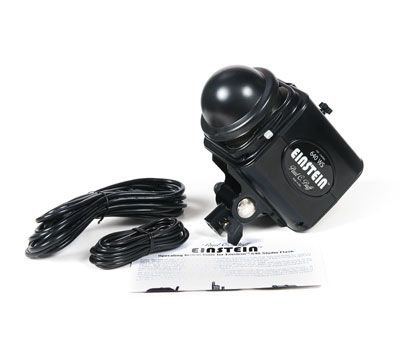
- the 1060836 frosted pyrex dome
- the 1060203 Einstein™ shipping cover
- the JD250W user-replaceable 250 Watt modeling lamp
- the MAXFT12MMUV user-replaceable flashtube
- the ABSC standard 15-foot sync cord (1/8" to PC)
- the UPC15 standard 15-foot grounded power cord**
- a back-up SR5-F type 8A fuse
(additional replacements are available from Digi-Key) - your Einstein™ owner's manual
**The Einstein™ arrives with a standard US power cord (IEC connector to 3-prong North American plug). To use the Einstein™ in other countries with different outlet configurations, you can purchase a standard power cord with an IEC connector on one end and the suitable plug for your location on the other.
Note: The Einstein™ DOES NOT arrive with a reflector or the CSXCV transceiver. The unit is compatible with our full line of reflectors and for general use, we recommend the 8.5HOR reflector. Additionally, the Einstein™ is designed for use with our CyberSync™ system and includes a slot for the CSXCV transceiver, but this item is NOT included.
Connecting the flash unit to your camera: The Einstein™ flash unit arrives with the ABSC standard 15-foot sync cord for hardwired connection to your camera. The cord connects to the flash unit on the unit’s back control panel (1/8-inch sync plug), then connects to your camera’s PC-sync outlet. This outlet may be labeled “PC sync,” “PC terminal,” “X-sync socket,” “external flash connector,” or “flash sync terminal” – the label varies by camera manufacturer. If your specific camera does not have a PC outlet, we offer a hot shoe adapter that fits in the standard ISO hot shoe of most cameras to enable PC-connection. For additional flash/camera synchronization options, see the information below about remote controls.
Light Stands: The Einstein™ flash unit must be securely mounted to a light stand for use. The stand mount is compatible with all Paul C. Buff light stands as well as most standard light stands having top couplers up to 5/8-inch.
Portable Power: For portable, battery power we recommend the use of our Vagabond Portable Power Systems.
Remote Controls: Einstein™ includes a slot for the CyberSync™ CSXCV Transceiver for use with the Cyber Commander™ to provide complete wireless firing and parameter adjustment. With this setup, the Cyber Commander™ can be used to remotely power on an Einstein™ unit that is plugged into a power source. The unit may be used with all CyberSync™ transmitters and receivers. Einstein™ may not be used with the LG4X wired remote control or older Paul C. Buff™ remotes incorporating the telephone cord connection. The unit is compatible with most other third party triggering receivers (such as the PocketWizard®). A 1/8-inch to 1/8-inch non-attenuated mini male mono cord such as our CSSC is required to connect the receiver to the Einstein™.
PLM™ and Umbrellas: The Einstein™ unit has an umbrella shaft that runs along the top length of the unit housing, fitting standard umbrella poles up to 23/64” (approx. 9mm) in diameter. It may be used with the PLM™ system (both the current model and previous models) as well as retired Paul C. Buff™ umbrellas. The PLM™ system's the on-axis speedring mount may be used as well.
Softboxes: The faceplate on each Einstein™ unit has four holding fingers that expand and contract to hold speedrings for softbox and octabox attachment. The unit may be used with any of our foldable softboxes, octaboxes or stripbox as well as retired models of Paul C. Buff™ softboxes and octaboxes. When using softboxes by other manufacturers, you will need to get a Paul C. Buff™ compatible speedring.
Reflectors: The four holding fingers on the faceplate also expand and contract to hold various reflectors. While the Einstein™ does not arrive with a particular reflector, for general use we recommend the 8.5HOR 8.5-inch high-output silver reflector. The unit is additionally compatible with our 7AB/R 7-inch silver field reflector, the 11LTR 11-inch long-throw reflector, the 22HOBD and 22HOBD-W beauty dishes, the UBR background reflector, and the 7UR reflector. The UMF LiteMod™ Unit Mainframe (and its associated accessories) may also be used.
Gels and Filters: Our standard gels and filters (CF6, CF20, WF6, UV6, DF6 and ND6) may all be used with Einstein™ units, used with the LiteMod system or with the 7-inch or 8.5-inch reflector.
Travel Gear: One Einstein™ unit can be carried in our PCBBAG Paul C. Buff, Inc.™ single-light carrying bag (with the shipping cover, either the 7” or 8” reflector, cords and room for other small accessories). For consideration of travel cases from other manufacturers, the Einstein™ dimensions are 7" height x 5.4" width x 7.8" length (with lamps, dome and shipping cover in place; mounting hardware attached).
Replacing Einstein™ Components: For future replacement needs, the flashtube used in the Einstein™ unit is the MAXFT12MMUV flashtube. This is a user-replaceable tube arriving with instructions for replacement. The modeling lamp used in the unit is the JD250W modeling lamp, also user-replaceable. The user-replaceable fuse holder (located on the back control panel of the unit) takes an SR5-F type 8A fuse. Each unit arrives with this fuse in place on the unit and an additional back-up fuse provided. If further fuse replacement becomes necessary, additional fuses may be purchased at Digi-Key.
For additional questions about Einstein™ compatibility, please contact our customer service team.
Light Stands: The Einstein™ flash unit must be securely mounted to a light stand for use. The stand mount is compatible with all Paul C. Buff light stands as well as most standard light stands having top couplers up to 5/8-inch.
Portable Power: For portable, battery power we recommend the use of our Vagabond Portable Power Systems.
Remote Controls: Einstein™ includes a slot for the CyberSync™ CSXCV Transceiver for use with the Cyber Commander™ to provide complete wireless firing and parameter adjustment. With this setup, the Cyber Commander™ can be used to remotely power on an Einstein™ unit that is plugged into a power source. The unit may be used with all CyberSync™ transmitters and receivers. Einstein™ may not be used with the LG4X wired remote control or older Paul C. Buff™ remotes incorporating the telephone cord connection. The unit is compatible with most other third party triggering receivers (such as the PocketWizard®). A 1/8-inch to 1/8-inch non-attenuated mini male mono cord such as our CSSC is required to connect the receiver to the Einstein™.
PLM™ and Umbrellas: The Einstein™ unit has an umbrella shaft that runs along the top length of the unit housing, fitting standard umbrella poles up to 23/64” (approx. 9mm) in diameter. It may be used with the PLM™ system (both the current model and previous models) as well as retired Paul C. Buff™ umbrellas. The PLM™ system's the on-axis speedring mount may be used as well.
Softboxes: The faceplate on each Einstein™ unit has four holding fingers that expand and contract to hold speedrings for softbox and octabox attachment. The unit may be used with any of our foldable softboxes, octaboxes or stripbox as well as retired models of Paul C. Buff™ softboxes and octaboxes. When using softboxes by other manufacturers, you will need to get a Paul C. Buff™ compatible speedring.
Reflectors: The four holding fingers on the faceplate also expand and contract to hold various reflectors. While the Einstein™ does not arrive with a particular reflector, for general use we recommend the 8.5HOR 8.5-inch high-output silver reflector. The unit is additionally compatible with our 7AB/R 7-inch silver field reflector, the 11LTR 11-inch long-throw reflector, the 22HOBD and 22HOBD-W beauty dishes, the UBR background reflector, and the 7UR reflector. The UMF LiteMod™ Unit Mainframe (and its associated accessories) may also be used.
Gels and Filters: Our standard gels and filters (CF6, CF20, WF6, UV6, DF6 and ND6) may all be used with Einstein™ units, used with the LiteMod system or with the 7-inch or 8.5-inch reflector.
Travel Gear: One Einstein™ unit can be carried in our PCBBAG Paul C. Buff, Inc.™ single-light carrying bag (with the shipping cover, either the 7” or 8” reflector, cords and room for other small accessories). For consideration of travel cases from other manufacturers, the Einstein™ dimensions are 7" height x 5.4" width x 7.8" length (with lamps, dome and shipping cover in place; mounting hardware attached).
Replacing Einstein™ Components: For future replacement needs, the flashtube used in the Einstein™ unit is the MAXFT12MMUV flashtube. This is a user-replaceable tube arriving with instructions for replacement. The modeling lamp used in the unit is the JD250W modeling lamp, also user-replaceable. The user-replaceable fuse holder (located on the back control panel of the unit) takes an SR5-F type 8A fuse. Each unit arrives with this fuse in place on the unit and an additional back-up fuse provided. If further fuse replacement becomes necessary, additional fuses may be purchased at Digi-Key.
For additional questions about Einstein™ compatibility, please contact our customer service team.
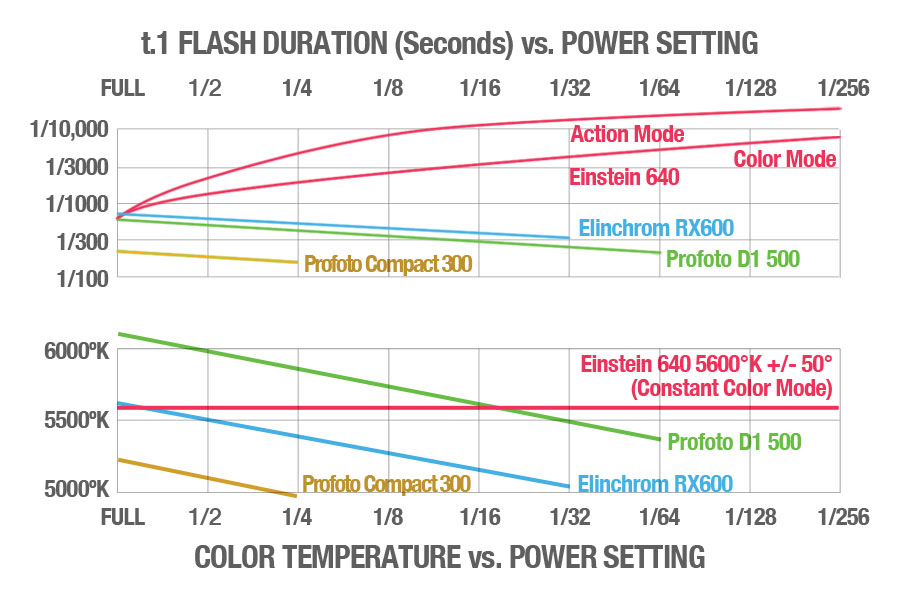
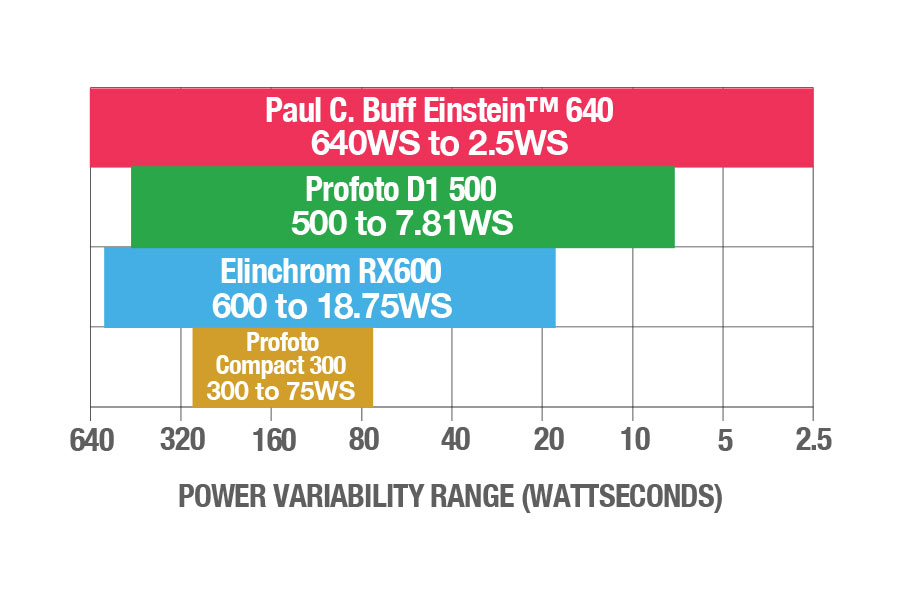
Graphs derived from published specifications and/or lab testing.
| Current Version | Date | Instructions | Size |
| Version 50 | November 14, 2013 | Click Here | 1.0 mb |
The Version 50 firmware updates from Version 31 firmware:
- Downgrading to a previous version of firmware is NOT possible after the version 50 update is performed.
- Do NOT attempt to load the firmware more than once or if V50 is otherwise already installed. If you already have version 50 firmware or if you are uncertain as to whether or not the update was successful, do not attempt to update the firmware again - contact customer service.
- AFTER THE UPDATE IS PERFORMED, the updated Einstein™ unit can accept both MicroSD cards (up to 2GB in size) and MicroSDHC cards (up to 32GB in size). The MicroSDHC card has the same build and size of the MicroSD card, but it offers greater capacity and transfer speed.
- Please note that the use of a MicroSDHC card is only permissible AFTER THE UPDATE. To perform the update, you must use a MicroSD card (2GB or less in size).
- AFTER THE UPDATE IS PERFORMED, cards can be formatted on Mac Systems (FAT32 formatting).
- Includes all previous firmware updates (click here for more).
For this update, you will need:
- a standard-capacity MicroSD card (2GB or less in size)
- a memory card reader capable of accepting MicroSD cards
Do I need an update? How do I know which version I have?
When your Einstein™ unit is first powered on, the firmware version will flash on the bottom of the screen for approximately 2 seconds. The firmware version can also be found on the diagnostics screen in the lower left corner. If you can’t find it, call us and we’ll help determine your version.
Please read all instructions before beginning this firmware update. Even if you have updated the firmware on your Einstein™ unit before, please review the instructions for this update as some steps have changed and there are special requirements that are specific to this update.


